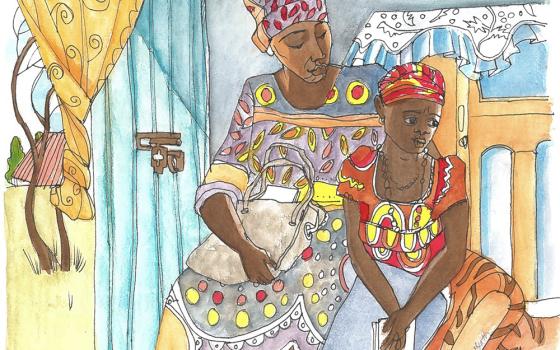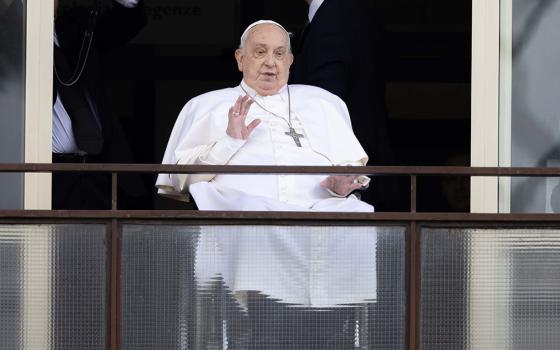The apostolic visitation, which sowed much division and cast a dark shadow over the lives and work of U.S. women religious for nearly six years, is finally drawing to an end. Beleaguered as we are, for this we should express gratitude.
To quote from T.S. Eliot: "Not with a bang but a whimper."
The head of the Vatican's religious congregation, Cardinal João Bráz de Aviz, whose heart has never been in this investigation, an investigation he inherited, deserves praise for attempting as best he can to stop the bleeding.
More will be required if the deep wounds caused by this abuse of episcopal authority are to be attended to.
From all corners, we hear that this report -- indeed, the entire six-year effort -- has made a positive contribution to religious life. What we are witnessing here is a form of institutional cover-up.
We need to step back. Lacking an examination into the causes that led to this assault on women religious (yes, it has been an assault), the wounds will persist. Without substantive attitudinal and structural changes, not among the women investigated, but rather those who initiated the investigation, this grand mistake and others like it will be repeated.
Yes, this long-awaited visitation report can be viewed as a laudatory achievement within a certain context. It rightly expresses gratitude and praise for the women's work while offering only minor and vague corrective suggestions. But even these -- center yourselves on Christ, consider your liturgies -- come off as somewhat condescending. Such is the problem and fundamental weakness with an exclusively male authority structure. The days are long past when an exclusive group of men can pass credible judgment on women. Our own bishops found this to be the case when they attempted -- and ultimately dropped the idea -- to write a pastoral on women.
Speaking of the apostolic visitation, it's the larger context, conditions at the Vatican that led to the investigation that need more flushing out if real healing is to occur.
The visitation is but one of two assaults in content and process that the Vatican has inflicted upon the women religious. Both were hatched without the women's consultation and both came to be because a few men couldn't force themselves to sit down and honestly discuss the issues at hand in their offices or, better, over a few meals. What was lost from the start was the interplay of real people and the humanity that surfaces in such contacts over time. Void of the human, which is often messy and often gray, the conflict drew more stark, more threatening. This is how fear is born, leading to unbending positions and alleged doctrinal breaches. Ultimately, pretty counter-productive stuff.
In this same fearful 2008 Vatican atmosphere, we witnessed another assault. The Vatican's Congregation for the Doctrine of the Faith announced its doctrinal investigation of the Leadership Conference of Women Religious, the cerebral core of U.S. women religious communities. Admittedly, it is easier to say now, but even then we knew so much more could have been achieved -- with more positive results -- had the men and the women developed closer working and social relationships.
This second investigation lingers on. The Vatican claims it involves doctrine. It certainly does not involve the Creed. Jesuits never became Dominicans nor Dominicans, Jesuits. But they both advance a wider church mission. Why not the men and women? Clergy and religious? The doctrinal congregation's investigation of LCWR continues with little to no hope that anything positive -- short of its own conclusion -- will occur. It's rather like a satellite circling a mother ship in space, only the mother ship has slipped away. With every new revolution, we are left to wonder why the mother ship doesn't end the loneliness and call the child home.
The apostolic visitation's final report encourages all to go forward in a spirit of "collaborative trust." Generous and accommodating statements by women religious at a press conference Tuesday in Rome notwithstanding, this is precisely what will remain missing short of a Vatican restructuring, one that leads to the inclusion of women as true collaborators in church management matters. This is not a power matter; it is a human matter. This is not to make women more powerful; or men, less; it is to make our church more effective.
An air of mystery
The apostolic visitation report itself is missing a couple of key elements that still must be addressed if full healing is to be achieved: The reports submitted to Rome as part of this process remain sealed, and there is no accounting for the origins of this investigation.
From the start of the apostolic visitation, women were not informed of how they came to be the objects of the investigation. Nor were they consulted on the process by which the investigation would be carried out. Nor were they allowed to be, in any meaningful way, agents in the formation of the content of the investigative reports.
Collaboration requires two-way transparency. Individual apostolic visitation congregation reports should be accompanied with all written materials culled from the work of the investigators. Each local community has the right to know what information -- some of it possibly mistaken, however pure the intention -- will now be permanently filed about it in Rome.
At the very least, individual congregations should be allowed to see the reports written and submitted to Rome and given the opportunity to respond to them.
We are told each of the local congregations visited and some congregations that have "particular concerns" will receive individual apostolic visitation reports. This raises a series of questions that must be answered: What is the purpose of these reports? What will result? Has the process not ended for these groups?
The final general report, released Tuesday, states: "We express the hope that together we may welcome this present moment as an opportunity to transform uncertainty and hesitancy into collaborative trust, so that the Lord may lead us forward in the mission he has entrusted to us on behalf of the people we serve."
Amen to this. It is, indeed, time to walk together -- clergy, religious, lay -- yes, in different roles with different tasks, but as equals, commissioned in baptism, in faith, and as devoted followers of Christ.
Missing in the final report, despite repeated expressions of gratitude within in it for the work of the women, is adequate recognition of the adventurous and faithful spirit in which they have faithfully lived out the Gospels, sometimes in lonely fashion, and have answered the call of the Second Vatican Council for decades. Fairness requires this kind of recognition and affirmation. But it also begs the question: Why call such an investigation in the first place?
The seeds of the ill-fated effort are not covered in the report. Therefore, it is easy to overlook and, intentionally or not, paper over the deep fears and misplaced suspicions that motivated Vatican prelates during Pope Benedict XVI's papacy. Indeed, the document, finding no alleged infractions, confirms these misperceptions, leading the casual observer to wonder what the investigation was all about.
It was Cardinal Franc Rodé, then head of the Vatican office for religious, who initiated the investigation in 2008 with the support of U.S. cardinals in Rome. He insisted a year later the review should not be seen as a sign of mistrust. Then he acknowledged there was concern at the Vatican about "a certain secular mentality" that has spread among the women religious communities "and, perhaps, also a certain 'feminist' spirit."
For Rodé and other prelates, it seems that a "feminist spirit" largely consists of women who think for themselves. God wants us to think. The problem for some prelates is that women cannot become uneducated. Accommodate, men. The best is yet to come.
The real cost of the apostolic visitation
Another question in need of examination is: What has the report taught us about religious life today?
We are being encouraged to celebrate the 12-page, 5,200-word report as a remarkable contribution to religious life. In the report, we find that U.S. women religious communities are varied "in charism, mission, spiritual traditions, and communal life"; that women who reside alone "do so for reasons of ministry or health"; that the promotion of religious vocations is a challenge; that the roles of superiors have always been of great importance; that the majority of sisters have a positive image of their major superiors; that women exercise wise stewardship, "socially responsible investing and strategic planning"; and the women "generously contribute to the church's efforts to alleviate poverty throughout the world."
No earthshaking surprises here.
We could have been spared this long, sad chapter in church history were simple information the true goal, if instead of the apostolic visitation, some Roman prelate had the smarts to call and interview any one of a number of sisters: Sandra Schneiders, Helen Garvey, Pat Farrell. Better, the prelates could have had a few good Italian meals with the women and taken notes. There are no mysteries here. Again, missing is true collaboration, a recognition of each other's humanity. Even, possibly, friendship
The report concludes with an eyebrow-raising paragraph that says the apostolic visitation has been modeled on the Gospel encounter between Mary and her cousin Elizabeth, who "overcame fear and uncertainty to joyfully embrace their role in God's plan of salvation." It says the visitation process offered the women "new opportunities" to discover God's presence and salvific action.
Yes, women religious bonded as never before as a result of the investigation, within communities and across traditional congregational lines, as they faced what they perceived as a common oppressor. But is this the model of church we really want to offer the wider world?
What has been the real cost? It has been enormous, incalculable.
Countless years of distraction from the true missions these beleaguered women have given their lives to: serving the needy and marginalized.
If it patterns other Vatican investigations, this report will be quickly shelved and forgotten. The real achievement may be that it causes no further unnecessary and unwarranted pain. However, the secretive manner in which it was initiated and conducted, its one-way, top-down process, causing years of humiliation and pain, will not easily dissolve in our collective memories.
We can only hope lessons have been learned.
The apostolic visitation, then, whatever its initial intentions, finally reveals more about our church, about anachronistic structures, entrenched clericalism, the undue separation of men and women, and the lunacy of men taking on the task of investigating women than it provides fresh insights into religious life or answers to the complex challenges facing the women religious today.
If we are looking for a silver lining, it's here -- if one cares to learn.
[Thomas C. Fox is NCR publisher and director of Global Sisters Report. He can be reached at tfox@ncronline.org.]



